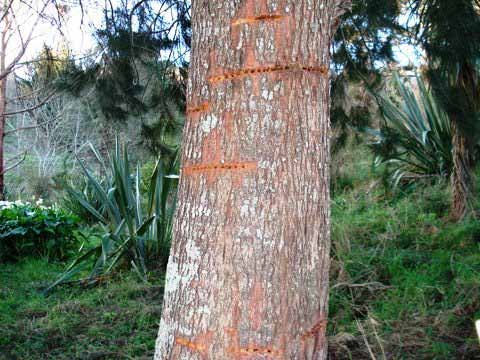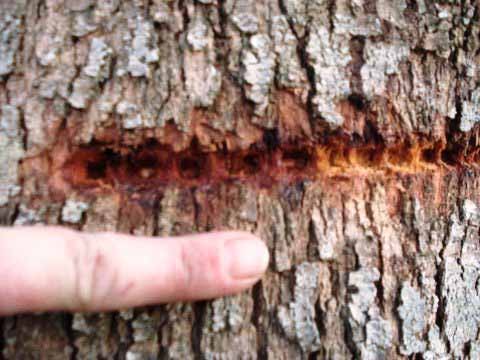PESTS AND DISEASES OF FORESTRY IN NEW ZEALAND
Kaka damage to trees
Scion is the leading provider of forest-related knowledge in New Zealand
Formerly known as the Forest Research Institute, Scion has been a leader in research relating to forest health for over 50 years. The Rotorua-based Crown Research Institute continues to provide science that will protect all forests from damage caused by insect pests, pathogens and weeds. The information presented below arises from these research activities.
From Forest Health News 239, August 2013.
Recently there have been reports in the press of kaka (Nestor meridionalis), a native parrot, stripping bark from trees in the Wellington Botanic Garden. North American conifers seem to be the trees that are most affected and some have been so badly damaged that consideration is being given to felling them.


The source of the kaka is undoubtably the Zealandia sanctuary (formerly the Karori Wildlife Sanctuary). As the crow flies, or in this case the kaka, Zealandia is only about 1.5 km from the botanic gardens. Kaka have been virtually extinct in the Wellington region since the early 1900s and they were transferred back into the wild at Zealandia in 2002. They are breeding well and over 300 birds have been banded there.
The kaka strip the bark of trees or, depending on the tree species, make holes through to the bark to gain access to the cambium. They then use their “brush tongue” to feed on the sap. Most of the damage appears to occur in winter and early spring, perhaps this is because other food sources are relatively scarce at this time of year.
The kaka’s diet also includes fruits, seeds, flowers, buds, nectar and invertebrates. They will use their strong beaks to dig huhu grubs (Prionoplus reticularis) out of dead wood.
Kaka damage has been recorded from quite a range of native tree species including Beilschmiedia, Dacrydium, Griselinia, Metrosideros, Nothofagus, Olearia, Podocarpus, Pseudopanax and Weinmannia. It has also been recorded on exotic hosts including Casuarina, Eucalyptus and Pinus. It almost certainly occurs on other hosts as well and occurs throughout most of the country including some offshore islands.
Periodically kaka damage to mature Pinus radiata has been evident in southern Kaingaroa Forest adjacent to Whirinaki Forest Park. Most of the damage consists of the bark being stripped off the tree leaders. For further information on the Zealandia sanctuary see: http://www.visitzealandia.com.
John Bain
This information is intended for general interest only. It is not intended to be a substitute for specific specialist advice on any matter and should not be relied on for that purpose. Scion will not be liable for any direct, indirect, incidental, special, consequential or exemplary damages, loss of profits, or any other intangible losses that result from using the information provided on this site.
(Scion is the trading name of the New Zealand Forest Research Institute Limited.)



